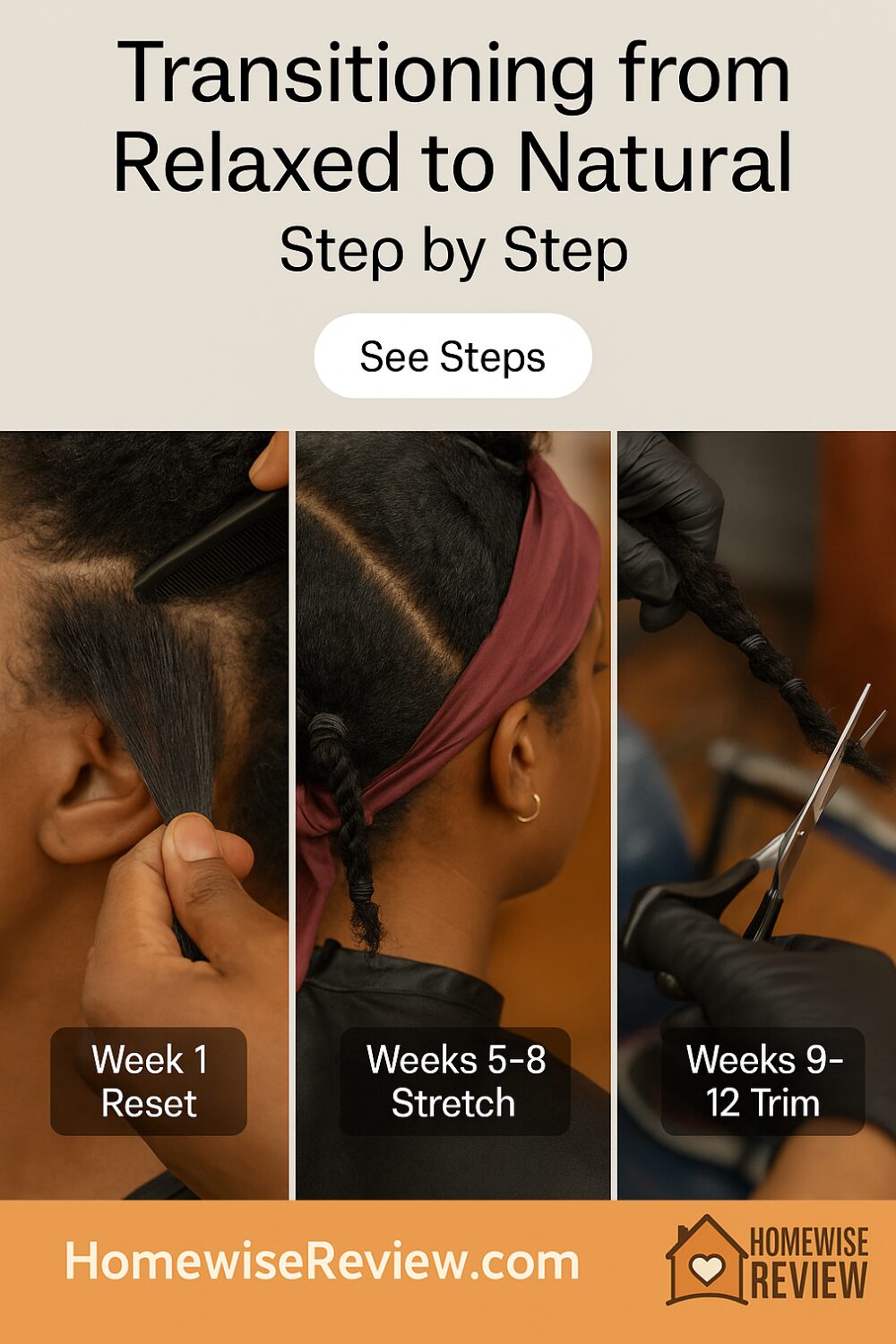
What transitioning really means
Transitioning is the period when you stop chemical relaxers and let natural texture grow in while keeping your relaxed ends. You are caring for two different hair types at once. The fragile point where they meet is the line of demarcation. Your success depends on keeping that line moisturized, supported with occasional protein, and handled with the gentlest hands.
Your 90-day starter plan at a glance
| Timeframe | Focus | What you do | Heat rule |
|---|---|---|---|
| Weeks 1–4 | Reset and protect | Gentle cleanse, weekly deep condition, start low-manipulation styles | Blowout rarely, no flat iron |
| Weeks 5–8 | Strength and stretch | Light protein 1–2 times, master banding or braids for stretch | Cool or warm dryer only |
| Weeks 9–12 | Shape and simplify | Micro-trim ragged ends, refine routine, keep styles lasting | Only diffuse or hooded dryer |
Core supplies checklist
- Sulfate free or gentle shampoo that still cleans
- Slippy conditioner and a deep conditioner or mask
- Light protein treatment for every few weeks
- Leave-in, cream, foam or gel for hold, light oil or serum for ends
- Wide-tooth comb, flexible detangling brush, section clips
- Satin bonnet or scarf, satin pillowcase
- Soft scrunchies or covered bands for stretching
Step by step routine for transition wash day
- Pre-section and soften
Mist with warm water. Add a little conditioner for slip. Part into 6 to 10 sections and twist. Work one section at a time. - Cleanse the scalp, cushion the lengths
Use a gentle shampoo at the scalp. Squeeze suds down the hair, do not scrub the ends. Rinse well. Clarify once a month if you use heavy stylers. - Condition and detangle with patience
Load conditioner on soaking-wet hair. Detangle from ends to roots with fingers, then a wide-tooth comb, then a flexible brush only if needed. Retwist each finished section so it stays stretched. - Deep treat based on how your hair feels
- Feels mushy, will not hold a set, breaks when wet: choose a light protein and follow directions.
- Feels rough, looks dull, tangles fast: choose a rich moisture mask.
Rinse cool so the cuticle lays flatter.
- Layer leave-in, cream, and hold
On damp hair, apply a leave-in for slip, a small amount of cream for moisture, then foam or gel for hold. Seal only the last inch with a few drops of oil. - Set in a protective, low-tension style
Try medium braids or flat twists in sections, or banding for stretch. Let hair dry fully under a hooded dryer or air dry with time. Do not separate while damp.
Daily and weekly rhythm that prevents breakage
- Daily: Keep hands off. Smooth a pea of leave-in on the line of demarcation if it looks thirsty. Wrap or bonnet at night.
- Every 3–4 days: Light refresh. Mist with water or leave-in, add a touch of foam, then band or retwist 4 to 6 big sections for 20–40 minutes, release when dry.
- Every week: Wash day routine above.
- Every 6–8 weeks: Micro-trim 0.25–0.5 inches to remove frayed relaxed ends before they split up the strand.
Protein and moisture schedule
| Hair signal | What it means | What to use | How often |
|---|---|---|---|
| Hair feels gummy, stretches too much wet | Needs protein support | Light protein treatment | Every 3–4 weeks |
| Hair feels rough, snaps dry | Needs moisture | Deep conditioner or mask | Weekly |
| Ends feel crunchy only | Seal issue | A few drops of oil on ends | After styling only |
Stretching methods that protect the line of demarcation
- Banding: Place soft bands every 1–2 inches down each damp section. Great for root control and fast drying.
- Braids or flat twists: Even tension, longer wear, less puff in humidity.
- Roller sets or flexi rods: Low manipulation with smooth results if you enjoy setting styles.
Avoid tight ponytails or small, heavy extensions early on. Keep tension mild so the seam between textures does not snap.
Protective styles that work while you grow
- Medium braids or flat twists you can redo weekly.
- Wigs with a flat twist base so your hair rests under a breathable cap.
- Chunky twists tucked into a bun for work weeks.
If you add extensions, choose light hair, ask for knotless or low-tension installs, and keep styles no longer than six to eight weeks with scalp care in between.
Heat, tools, and what is safe
- Save flat irons for rare occasions. If you do press, keep the iron near the mid-300s, work tiny sections, and use a proper heat protectant.
- Drying heat is safer when indirect. Hooded dryers and diffusers beat high direct heat.
- Brushes should flex. Hard, tight combing is what shreds the seam between textures.
Big chop or long transition, how to choose
- Big chop: Fast reset, clearer curl pattern, easiest routine, short hair learning curve.
- Long transition: Keeps length, more styling options right away, requires patience and trims.
There is no wrong choice. Many people trim gradually, then do a final chop once new growth reaches a length they like.
Troubleshooting
- Breakage at the seam: Add a light protein treatment, reduce manipulation, switch to braids or flat twists, and trim rough ends.
- Frizz by day two: Use smaller sections when setting, add a thin layer of foam or gel, and dry fully before takedown.
- Itchy scalp in protective styles: Rinse or mist with diluted shampoo or a scalp tonic once a week, then moisturize the parts lightly.
- Tangles after takedown: Load conditioner, detangle in sections, and cut shed hair loose rather than yanking.
Final Thoughts
Transitioning is easier when you keep the routine quiet and consistent. Work in sections, treat based on how your hair feels, stretch with gentle methods, and trim little by little. Protect the line of demarcation, wrap at night, and choose styles that do not fight your texture. In a few months you will have enough new growth to shape confidently, and your wash days will get simpler.
See Also
Pre-stretching and smart detangling keep that fragile seam safe. Start with Stretching 4C Hair Without Heat to learn spacing and tension that tame roots without breakage, then choose tools from Best Brushes for 4C Hair Detangling and Stretching so slip comes first, not force. If your cleanser leaves you squeaky and tangled, switch to one from Sulfate Free Shampoos for Natural Hair That Actually Clean and keep moisture steady all week.
When the seam feels weak or your set will not hold, add a light boost from Protein Treatments for Breakage in Natural Hair and keep nighttime protection tight with Nighttime Routine for Natural Hair That Prevents Breakage. These five guides connect smoothly to your transition plan and help you keep every inch you grow.
FAQs
How long does a typical transition take
Six to twelve months is common. Trim a little every 6–8 weeks or wait for a final chop once you reach your comfort length.
Do I need to stop heat completely
You do not have to, but less direct heat means fewer snapped seams. Stick with hooded dryers and only occasional flat ironing with a real heat protectant.
What is the fastest way to lose less hair on wash day
Detangle on soaking-wet hair loaded with conditioner, work in small sections, and keep tension even. Stretch styles between washes so hair tangles less.
Should I keep using relaxer on edges while I grow out
No. That creates overlap and weak spots. Smooth edges with a soft brush and a no-flake gel instead.
How do I know when to big chop
When most of your ends feel rough, styles fight you, or your new growth is at a length you like. A micro-trim first can make the decision feel easy next wash day.




